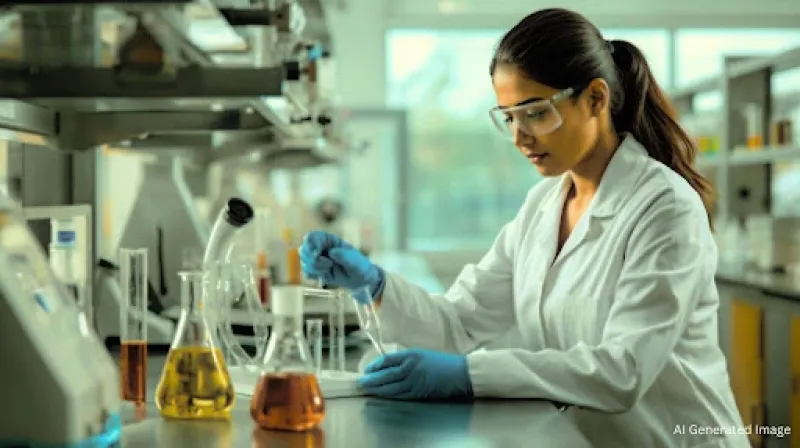
Researchers from Indian Institute of Technology Jodhpur and Indian Association for the Cultivation of Science (IACS), Kolkata, have made a breakthrough in both sustainable chemistry and cancer drug discovery, developing an efficient, metal-free method to create a new class of potent anti-cancer molecules. The research solves a long-standing problem in organic synthesis: installing a sulfur-containing group onto a specific, hard-to-reach location on a common chemical structure known as an aniline derivative. Aniline is an aromatic organic compound with the formula C₆H₅NH₂ with a ring-like structure. The resulting compounds, called S-aryl dithiocarbamates, have demonstrated valuable antiproliferative activity against breast cancer cells at a nanomolar level by interfering with the cell's internal scaffolding.
The challenge in synthesising S-aryl dithiocarbamates lies in the ability to perform a reaction known as meta-C-H functionalization on anilines. The aniline ring has three possible sites for substitution: ortho, meta, and para. Due to the molecule's inherent electronic properties, most conventional reactions naturally favour the ortho and para positions, making the meta position notoriously difficult to target selectively. Previous attempts to forge this crucial meta-C-S bond often required multi-step processes, complex starting materials, expensive and toxic transition metal catalysts, and harsh, high-temperature conditions.
This new methodology, a triumph of green chemistry, is a metal- and additive-free, one-pot, multicomponent reaction that operates under mild, room-temperature conditions. The process begins by reacting p-anisidines (a type of aniline) with an iodine(III) reagent, which generates a highly reactive intermediate called a quinone imine ketal (QIK). This QIK then immediately reacts with carbon disulfide and an aliphatic amine, all in the same flask, to form the desired S-aryl dithiocarbamate. The team successfully scaled up the reaction, demonstrating its industrial applicability by producing the model compound in a good yield of 78% on a 1.1-gram scale.
The broad scope and robustness of the reaction are particularly noteworthy. The method was successfully applied to perform late-stage functionalization, meaning it could modify complex molecules that are already biologically relevant. The scientists successfully installed the sulfur group onto derivatives of amino acids, like alanine and L-proline, pharmaceuticals such as the pain relievers ibuprofen and naproxen, and natural products like menthol and D-ribose. This versatility demonstrates the method's potential for rapidly generating new drug candidates. Furthermore, the resulting dithiocarbamates are not chemical dead ends; they can be easily converted into other highly valuable sulfur-containing functional groups, such as thiols, thioethers, and sulfones, which are common motifs in medicinal chemistry.
The goal of this complex chemistry was to find new treatments for disease, and the biological results are highly promising. Sulfur-containing organic molecules are already widely prevalent in medicine, accounting for 20% of all drugs approved by the FDA. The researchers focused their biological studies on breast cancer, a heterogeneous group of cells that often develops resistance to current treatments.
Did You know? Sulfur-containing molecules are incredibly important in medicine, accounting for approximately 20% of all drugs approved by the U.S. Food and Drug Administration (FDA). They are used to treat major diseases, including HIV, cancer, diabetes, and Parkinson's disease. |
The team screened their newly synthesised molecules against MCF-7 breast cancer cells and identified a lead compound, Compound 13, which exhibited exceptional potency. It was found to be 26-fold more potent than a similar compound from the team's previous work. Crucially, Compound 13 showed a high degree of selectivity, exhibiting significantly higher cytotoxicity toward breast cancer cells than non-cancerous cells.
Further investigation revealed that Compound 13 acts as a microtubule-polymerising agent, a mechanism similar to the established chemotherapy drug Paclitaxel (Taxol). Microtubules are the cell's internal scaffolding that are essential for cell division. By stabilising these structures, Compound 13 prevents them from depolymerising, which halts the cancer cell cycle and triggers cell death (apoptosis). The compound's superior drug-like properties, including better oral bioavailability and lower predicted toxicity compared to Paclitaxel, were confirmed through computational analysis.
The new study represents a significant advance in synthetic chemistry by overcoming the intrinsic electronic bias of anilines to achieve a difficult meta-C-S bond formation. The new method is scalable and sustainable, avoiding the toxic, expensive, and harsh conditions of traditional C-S bond construction. Their methodology is robust and has already successfully delivered a highly promising, potent, and selective lead molecule for breast cancer therapy.
This article was written with the help of generative AI and edited by an editor at Research Matters.





